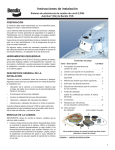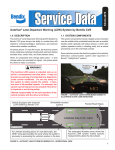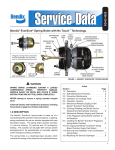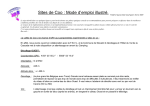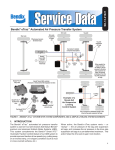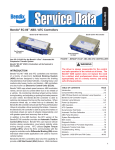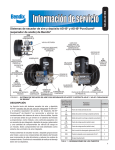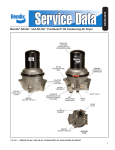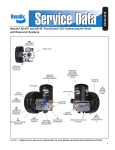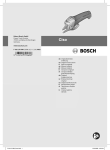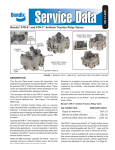Download BENDIX S-1580 User's Manual
Transcript
Installation Instructions AutoVue® Lane Departure Warning (LDW) System (3G) by Bendix CVS PREPARATION The vehicle must be parked on level ground. Switch off the ignition and disconnect the battery. Read and understand this document before beginning work. See the General Safety Guidelines on Page 2. Familiarize yourself with the kit contents; kits may feature speakers OR vibrating seat motors. A-Pilla r A-Pilla r Inspect the windshield area where the camera will be mounted for damage/cracks to be sure there will be a clear view. In some cases, it may be necessary to consult the vehicle's electrical schematic diagram(s) to plan access to the power supply and the turn-signal wiring. REQUIRED TOOLS 3¼ inch hole saw; wire strippers; wire crimpers; small "torpedo"-style level; test light or multimeter; and wire-pulling aids. Depending on the installation, see a list of optional tools on the final page. INSTALLATION OVERVIEW Plan the entire installation before beginning work. Some key points to bear in mind when planning the installation are: • Camera and processor placement - note that the length of the camera cord is approximately 22 in. (550 mm) long. • Wiring harness routing. • Access to the turn-signal wiring. • Dash switch location and wiring. • Speaker (or seat motor) locations and wiring. Where you are installing Autovue® LDW system on multiple vehicles, standardize the best installation for the model; this will assist when troubleshooting. Kit Contents KeyDescription Qty 1. Lane Departure Warning processor . . . . . 1 2. Camera with windshield bracket . . . . . . .1 3. Two 3½-inch speakers with covers (optional) . . . . . . . . . . . . . . . . . . . 2 4. Vibrating seat motors (optional) . . . . . . . .2 5. Enable/Disable switch . . . . . . . . . . . . .1 6. Driver information sticker (not shown) . . . . 1 7. Wiring harness (16 wire, color-coded; 20 foot) . . . . . . . . 1 8.Connectors . . . . . . . . . . . . . . . . . 14 9. 120 Ohm resistors (not typically needed) . . . 2 10. Other wiring harnesses . . . . . (varies by kit) 7 CAMERA MOUNTING 3 IMPORTANT: Before mounting the camera, verify that the vehicle is level. 1. Clean and inspect the inside of the windshield where the windshield bracket will be mounted. Use a denatured alcohol-based (or similar) cleaner. Cracks/distortion/ damage that would interfere with the camera operation are not acceptable. Clean and dry the windshield; the presence of grease or dirt will affect the adhesive used to hold the camera bracket in place. 2 8 5 1 (Sticker, vibrating seat motors, extra harnesses, and windshield bracket not shown) FIGURE 1 - INSTALLATION KIT 1 2. The precise location to install the camera bracket varies based on the vehicle make/model. See Figure 2. Find the horizontal offset “A”, and vertical offset “B” for the vehicle. The intersection of "A" and "B" will line up with a notch in the windshield bracket during installation. When measuring for the window bracket placement, measure from the center of the windshield and from the solid black area at the top. For vehicles with split-windshields, measure from the middle of the center divider. For onepiece windshields, typically there is a graphical indicator to show the middle point. 3. Use a measuring tape and fine-tipped pen to mark on the windshield the installation point for the bracket. 4. See Figure 2 Remove the plastic film from the adhesive on the windshield bracket. Place a small level on the leveling tabs. Touching only the top edge of the bracket to the glass at first, align your mark with the notch in the bracket. Adjust the angle of the bracket until it is level, then carefully bring the rest of the bracket into contact with the glass, making sure that the notch remains lined up with the point marked on the glass. While it is lightly 2 seated, verify again that the bracket is level — at this point some adjustment is still possible. Once you have confirmed that the bracket is completely level, press it firmly to the windshield for 10 seconds to ensure a good bond. 5. Install the camera onto the mounting bracket and route the harness to the compartment above. PROCESSOR PLACEMENT 1. The processor will typically be mounted on the passenger side of the vehicle in a front overhead compartment. When selecting the ideal location, be sure to consider that there must be no pinching or binding of the camera cable, and that there should be easy access to all of the unit's connections. 2. It is recommended to position the processor unit so that the large connector is oriented to the passenger side of the vehicle. A good practice is to leave 12 in. (or more) of excess harness on the connector side for a service loop. The processor should be mounted flat, using the hook-and-loop-fastener pad to attach it to the vehicle. Top of Windshield Model Argosy 1 Cascadia (AM) 8 Cascadia (OEM) 10 Freightliner Cent/Col. A Camera Location Code B Center Line Make* Notch in the Camera Bracket 1 Classic XL FL70 2 M2 4300 8100 8600 9200 2 “Torpedo” Level Rests on the Bracket Tabs International 9400 9900 Lonestar Pro Star Workstar/7000 Series Kenworth 2 T200 2 T600/800 3 T600/800 Flt Wndshld 7 T660 3 T680 T700 Mack 9 Pinnacle Vision 2 2 Camera Location Code Horizontal Offset Vertical Offset “A” “B” 1 9 ± 0.25 in. 2 ± 0.5 in. 2 6 ± 0.25 in. 2 ± 0.5 in. 3 9 ± 0.25 in. 3 ± 0.5 in. 7 7 ± 0.25 in. 3 ± 0.5 in. 8 7 ± 0.25 in. 2 ± 0.5 in. 9 9 6 ± 0.25 in. 2.5 ± 0.5 in. 2 10 8 ± 0.25 in. 2 ± 0.5 in. 378 379 385 386 389 Peterbilt 340 Car Hauler To determine the correct point on the windshield to line up to the notch in the camera bracket, use the Make/Model columns of the table (left) to find the Camera Location Code. The second table (below) shows the correct vertical and horizontal offset to use for each Code. 2 379 Car Hauler 384/386 with video 384/386 with Curved Windshield 387 (AM) 387 (OEM) 579 Sterling Volvo A-Line A-Line Car Hauler NonVolvo Engine Volvo Engine Western Star 4900 2 2 * All trade marks shown here are the property of their respective owners and are used for reference only. FIGURE 2 - LOCATING THE CORRECT POINT TO MOUNT THE CAMERA BRACKET 3 Retain All Harnesses NOTE: Store all the wiring harnesses supplied in the kit — including any not used in this installation — with the processor in the overhead compartment. Additional systems that interact with the Autovue® LDW system, may require these harnesses. WIRING HARNESS ROUTING See Figure 1. The 20 foot wiring harness can be routed via either, or both, A-pillars. Routing may depend on where the dash Enable/Disable switch will be located, and whether speakers or seat-motors are to be used to alert the driver. TURN SIGNAL CONNECTIONS 1. Test the turn signal system to verify that it is functioning correctly. 2. Refer to the wiring diagram for the vehicle to find wire numbers for the left and right turn signals. 3. As necessary, remove the vehicle trim/panels to gain access to the wiring looms where the left and right turn signal wires are located. Having confirmed each wire for function, be sure to mark each wire clearly for the next step. 5. Run the wiring harness to the location where the connection will be made. Refer to the tags on the wires and connect, by soldering or splicing, to their respective (left or right) turn signal positive wires. IGNITION, GROUND, AND BATTERY CONNECTIONS Three power connections must be made: 1. Ignition (Pin A9). Ignition power is required for the processor, the Enable/Disable switch, and for kits including seat motors, to the seat connector. Obtain ignition power at a good 12 Volt accessory location: typically at the fuse panel; or at the ignition switch. CAUTION: The Ignition power MUST come from a suitable vehicle circuit that is: • Switched on and off by the ignition switch; and, • Is protected by a fuse or circuit breaker with an electrical current rating of no greater than 15 Amps and no less than 5 Amps. Connect Ignition power to both the harness red wire marked IGNITION, and also to Pins 10 and 12 the Enable/Disable switch. Use 18 gauge wire as needed. 2. Ground (Pin B9). Locate a suitable location on the vehicle to make a good connection to chassis ground. Potential locations are: the fuse box; the vehicle's chassis; or the firewall near the steering column. If you select the chassis or firewall — and in making the ground, need to drill a hole — take care not damage, or interfere with other vehicle components. • Connect ground to the harness black wire marked GROUND, and also to Pin 2 of the Enable/Disable switch. Use 18 gauge wire as needed. FIGURE 3 - LOCATING THE TURN SIGNAL POSITIVE WIRES 4. Connect a test lamp, Voltmeter or Multimeter to each of the turn signal positive wires and use the following tests to confirm you have the correct wires. Verify that you find (for both the left and right wiring): • When the turn signal is off, the test lamp should be off (or 0v); • When the turn signal is operating, the test lamp should blink (or pulse 12v); • When the service brake pedal is applied (with the turn signal off), the lamp should be off (or 0v); • When the parking brake pedal is engaged or disengaged, (with the turn signal off), the lamp should be off (or 0v); and • When the headlights are switched on, (with the turn signal off), the lamp should be off (or 0v). 4 3. To the Battery (Pin A11). The battery connection must be made at a location where 12 Volt battery voltage is constantly present, regardless of the ignition state. This is essential for full functionality of the optional data recording features. Make sure that the battery connection is stable by confirming that the voltage level is (nominally) 12 Volts at the battery connection regardless of the ignition switch position. Right Speaker Positive - Blue Right Speaker Negative - Blue/white stripe Right Vibrating Seat Motor - Brown Left Vibrating Seat Motor - Pink Speed (Yellow/Black) Not Used RS232 COMM DB9 Ground - Black RS232 RX - Yellow LDW PROCESSOR RS232 TX - Orange Left Speaker Positive - Brown Left Speaker Negative - Brown/White Stripe LDW CAMERA Warning Enabled Lamp - Blue Ignition - Red 12 Volt Ignition Source 12V Battery Red/Yellow Stripe Green LED 10 Ignition - Red ABC 12 Volt Battery Source 9 (A, B, and C are Contact Designators for this Connector) Enable/ Disable Switch - Grey 1 Enable/ Disable Switch 2 4 Left Speaker 12 11 Ground - Black J1939 CAN Bus Amber LED J1939 Pos Yellow Status Lamp Output - Purple J1939 Neg Green Left Turn Signal Positive (Orange) Right Speaker Ignition - Red Chassis Ground (White) Right Turn Signal Positive Left Seat Motor Right Seat Motor NOTE: This wiring diagram shows both speaker and vibrating seat motor connections; actual harnesses will have only one or the other. FIGURE 4 - AUTOVUE® LDW SYSTEM WIRING DIAGRAM J1939 CAN BUS CONNECTION The J1939 CAN (Controller Area Network) Bus is a communications standard designed to permit vehicle devices to communicate with each other. To enable the full range of the Autovue® LDW system by Bendix CVS features, the designated wires in the harness need to be connected to the J1939 CAN Bus. Most vehicles have a 6- or 9-pin diagnostic connector, near the driver-side door, typically low down on — or under — the dash. See Figures 4 and 5. This connector is used by PC Diagnostics to examine engine performance data and Diagnostic Trouble Codes (DTCs), and is an ideal point to connect the AutoVue LDW system harness. NOTE: For vehicles built since 2005, the J1939 CAN Bus is almost always activated. In rare cases where J1939 CAN Bus is not found, see the Troubleshooting section. Gain access to the wires behind the connector. A yellow and green twisted pair of wires is the Standard for J1939 CAN Bus wiring; see the AutoVue LDW system harness 5 wires used for this purpose as an example of what to look for. Generally, it is best to splice in the new wires as close to the data connector as possible. For Vehicles with 9-pin Diagnostic Connectors Pin Location Signal Description C CAN_H CAN Bus, High D CAN_L CAN Bus, Low E CAN_GND CAN Ground This is a different CAN Bus DO NOT USE! H&J or a dashboard-punch to make the hole. Most dashboard materials are relatively easy to cut through, but be sure to avoid any damage to wiring or equipment behind the selected location. View Looking Into the Connector FIGURE 5 - 9-PIN DEUTSCH CONNECTOR: J1939 CAN BUS TERMINALS On vehicles with 9-pin connectors, splice the yellow wire of the harness to the yellow J1939 CAN Bus High (+) connected to pin C, and the green wire of the harness to the green J1939 CAN Bus Low (-) connected to pin D. Some vehicles with 9-pin connectors may be connected to two sets of twisted pair yellow and green wires. Only connect to the green and yellow wires at pins C AND D (J1939 CAN Bus). FIGURE 7 - EXAMPLE ENABLE/DISABLE SWITCH INSTALLATION See Figure 8 for the wiring connections. As you attach the wiring, since the terminals are not in numeric order, be sure to verify the exact location number for each wire as you assemble the connector for the back of the switch. CAUTION: If a second set of yellow and green wires is presently connected to Pins H and J be aware that this is a different CAN Bus - DO NOT USE THIS BUS for this kit. INCORRECT CONNECTION MAY CAUSE UNEXPECTED VEHICLE PERFORMANCE PROBLEMS. For Vehicles with 6-pin Diagnostic Connectors Pin Location Signal Description D CAN_H CAN Bus, High F CAN_L CAN Bus, Low 12 4 3 2 1 10 Terminal Numbers 9 5 6 7 8 11 View Looking Into the Connector Pin FIGURE 6 - 6-PIN DEUTSCH CONNECTOR: J1939 CAN BUS TERMINALS On vehicles with 6-pin connectors, splice the yellow wire of the harness to the yellow J1939 CAN Bus High (+, connected to pin D), and the green wire of the harness to the green J1939 CAN Bus Low (-, connected to pin F). ALERT: With either connector, IF FOUND, do not attempt to use sets of orange and green wires; these are J1708 Bus wires and this kit is not designed to use the J1708 Bus. ENABLE/DISABLE SWITCH Select a suitable location for the Enable/Disable switch, keeping in mind how much room will be needed for the switch and access to its wiring connections. A typical site is next to existing switches of the same size; use a spare switch location if available. Otherwise, use hand tools and/ 6 Color Description 1 Grey AutoVue Harness, Also Connects to Pin 4 2 Black Ground 4 Grey AutoVue Harness, Also Connects to Pin 1 9 Blue Warning Lamp Enabled 10 Red Ignition, Also Connects to Pin 12 11 Purple Status Lamp Output 12 Red Ignition, Also Connects to Pin 10 ® FIGURE 8 - ENABLE/DISABLE SWITCH CONNECTIONS DRIVER ALERT SYSTEMS - AUDIBLE OR VIBRATION VIBRATING SEAT MOTOR ALERT SYSTEM Kits will either contain a speaker-based alert system, or use vibrating seat motors in the driver's seat to provide feedback. AUDIBLE ALERT SYSTEM The standard location to install the speakers is above and/ or close behind, the head of the driver (and passenger). Check that the location selected has both room behind the panel for the speakers to fit, and in front for the speaker grills. A 3¼ inch hole saw can be used to cut the holes for the speakers. Select the correct set of speaker wires and pull each pair of wires to the respective side, through the hole into the cab. Harness Speaker Wire Color Where Used Brown / Brown and White Left (Driver Side) Dark Blue / Dark Blue and White Right (Passenger Side) Use the terminals supplied, or use solder, to connect the speakers to the harness. Install the u-nuts at the sides of the holes cut. With the speaker and grill aligned, install the screws supplied. See the speaker image in Figure 9. When the installation is complete, at vehicle start-up, the speakers will "chirp" in sequence (left then right) to confirm that they are functioning. See Figure 9 (NOTE: The exact kit components may vary from the items shown.) Instead of speakers, selected kits use vibrating seat motors to signal to the driver. For these kits, route the pink and brown harness wires to the floor at the back of the seat. The red wire that comes already installed to the smaller section of the connector needs to be run back to the ignition power (see the Ignition, Ground, and Battery Connections section.) Remove the bottom seat cushion from the driver's seat and take the cover off to reveal the foam. The motors will be installed so that they are under the driver's thighs. Plan the locations and then cut the foam as shown in Figure 9, including a center pocket for the vibrating seat motor assembly. As shown, leave a flap of foam to cover the motor. Run the wires from the motors to the back of the seat by cutting a slit part-way into the foam and routing the wires through it. A connector with two detachable halves is used to join the motor harnesses and the wiring from the system and ignition. Before cutting any excess from the wires, plan the location of the connector, making sure that there will be sufficient slack to allow the seat to move freely through its full range of motion. Verify also that the wiring will not be pinched when the seat is moved. Typical Speaker Location Kit Harness Featuring Vibrating Seat Motors Preparing and Installing the Vibrating Seat Motors: Routing the Wiring Preparing and Installing the Seat Connector Wiring Using the Delphi PED connector Black Red (Combined) Black FIGURE 9 - DRIVER ALERT SYSTEMS Pink Red (Factory Installed) Brown 7 Connections from the Vibrating Seat Motor Side Using Delphi connectors, install the vibrating seat motor wires into the smaller section of the connector. The black wire from the right motor goes into slot C, the black wire from the left motor goes into slot A, and the two red wires from the motors are joined together and go into slot B of the Delphi connector that is supplied with the kit. The seat cushion can now be replaced. Use wire loom protectors for any exposed wiring. Connections From the Harness Side This connector supplied has a red wire already installed into slot B; this wire must connect to a good 12 Volt ignition source protected by a fuse or circuit breaker with a current rating between 5 (five) and 15 Amps. Using Delphi connectors, install the pink wire into slot A and the brown wire into slot C. The pink wire is used to control the left vibrating seat motor and the brown wire controls the right motor by supplying the motor with a ground. Join the two halves of the connector together. Use wire loom protectors for any exposed wiring. FINAL STEPS AND SYSTEM TESTING Install the Driver Information Sticker in a suitable location on the vehicle, visible to the driver. Return all vehicle panels and wiring looms to their installed positions. Restore the battery connections. When the vehicle power is switched on the Autovue® LDW system by Bendix CVS will go through a self test: • If equipped with speakers, you will hear a chirp from the left and right speakers respectively, in that order. • If equipped with vibrating seat motors, you will feel a short pulse from the left and right motors respectively, in that order. Both the green and yellow indicator lights on the Enable/ Disable switch should remain on. Both the green and yellow lights should remain on until you reach 38 to 40 mph (61 to 64 km/h), at which point the system is active. Test drive the vehicle (both day and night where practical). 8 Enable/Disable Switch Lamp Behavior: Warning Enabled Lamp (Green) Status Lamp (Yellow) Warnings Ready Vehicle Speed < 37 mph (60 km/h) ON ON No Can’t Find Lane Markings ON ON No Vehicle Speed > 37 mph (60 km/h) AND Lane Markings Found ON OFF Yes Driver Presses Switch to Disable Warnings OFF OFF No System Diagnostic Trouble Code (DTC) Set OFF ON No Situation TROUBLESHOOTING: At start-up, if the green light on the Enable/Disable switch illuminates and then goes out after a few seconds, this typically indicates that the system is not finding the J1939 CAN Bus data link. If so, test the following: 1. Check for loose connections to the data link wiring. 2. Use PC diagnostics to check the J1939 CAN Bus. Two much more rare possibilities are: 3. The J1939 CAN Bus is not activated. Typically the J1939 CAN Bus can be activated via the engine diagnostic port using a laptop, or diagnostic computer. 4. The vehicle does not have the J1939 Bus wiring run from the engine ECM connector or Vehicle Control Unit. Consult the OEM documentation for the correct procedure to permit J1939 communications. Where this is necessary, the two 120 Ohm resistors are supplied in the kit to be used— if necessary — to assist with obtaining the 60 Ohms required across the yellow and green wires, so that the ECM recognizes that the J1939 Bus is in use. Status Lamp (Yellow) RESERVED Speed (NOT USED) RESERVED Ignition Left Turn Signal RS-232 TX Left Seat Vibrating Seat Motor (Optional) 12V Battery Right Speaker (+) (Optional) J1939 High Left Speaker (+) (Optional) J1939 Low Left Speaker (-) (Optional) RS-232 RX Right Speaker (-) (Optional) RESERVED Right Vibrating Seat Motor (Optional) Vehicle Ground Right Turn Signal Enable/Disable Switch RESERVED Warning Enabled Lamp (Green) RESERVED Connector Diagram (viewed from wiring side of harness connector): RESERVED = Reserved for future use. Pin Term Input/ Output Wire Color Connection Function A1 Left Speaker (+) (Optional) O Brown 8 Ohm, 25 W speaker (between A1 and B1) Generates audio warning during left side lane departure. A2 Right Speaker (+) (Optional) O Blue 8 Ohm, 25 W speaker (between A2 and B2) Generates audio warning during right side lane departure. A3 Left Vibrating Seat Motor (Optional) O Pink Vibrating seat motor (+) lead Generates seat signal during left side lane departure. A4 Left Turn Signal I Orange Vehicle left turn signal line Disable all warnings when turned on. A7 Status Lamp (Yellow) O Purple Low side of yellow LED Indicates to driver that the system is not ready to give warnings. A9 Ignition Voltage I Red Vehicle ignition switch Provides system power. Used for communication with other computer devices. A10 RS-232 TX O Orange Connects to RS-232 port, data receive input A11 Battery Voltage I Red/Yellow Vehicle battery feed Allows unit to store data during power down sequence after ignition has been turned off. A12 J1939 High I/O Yellow Vehicle J1939 Bus (high side) CAN Bus; Source of vehicle speed. B1 Left Speaker (-) (Optional) O Brown/White Stripe 8 Ohm, 25 W speaker (between A1 and B1) Generates audio warning during left side lane departure. B2 Right Speaker (-) (Optional) O Blue/White Stripe 8 Ohm, 25 W speaker (between A2 and B2) Generates audio warning during right side lane departure. B3 Right Vibrating Seat Motor (Optional) O Brown Vibrating seat motor (+) lead Generates seat signal during right side lane departure. B4 Right Turn Signal I White Vehicle right turn signal line Disable all warnings when turned on. B7 System Enabled Lamp (Green) O Blue Low side of green LED Indicates to driver that system is enabled. B8 Enable/Disable Switch I Grey Normally open, momentary switch connected to chassis ground Allows the driver to temporarily disable warnings in confusing situations (e.g. construction zones with multiple sets of lane markings.) B9 Vehicle Ground I Black Vehicle chassis ground System power return. Used for communication with other computer devices. CAN Bus; Source of vehicle speed. B11 RS-232 RX I Yellow Connects to RS-232 port, data transmit output B12 J1939 Low I/O Green Vehicle J1939 Bus (low side) FIGURE 10 - WIRING REFERENCE CHART 9 NOTES 10 NOTES 11 Bendix Technical Assistance Team For direct telephone technical support, call the Bendix Tech Team at: 1-800-AIR-BRAKE (1-800-247-2725). Tech Team members are available Monday through Friday, 8:00 A.M. to 6:00 P.M. ET. Or, if you prefer, e-mail us at: [email protected]. Please have the following information ready when you contact the Bendix Tech Team: Bendix product model number; part number and configuration; vehicle make and model. Tools Some installers have found the following items useful: • Delphi Crimper (part number 06285847) for switch contacts. • Panel Punch (part number DIN-132) for making the hole for the Enable/Disable switch. (www.panelpunches.com) Miscellaneous Supplies • Wire Loom Protectors (for the vibrating seat motor installation.) S-1580 © 2013 Bendix Commercial Vehicle Systems LLC, a member of the Knorr-Bremse Group. 7/13. All Rights Reserved. 12












